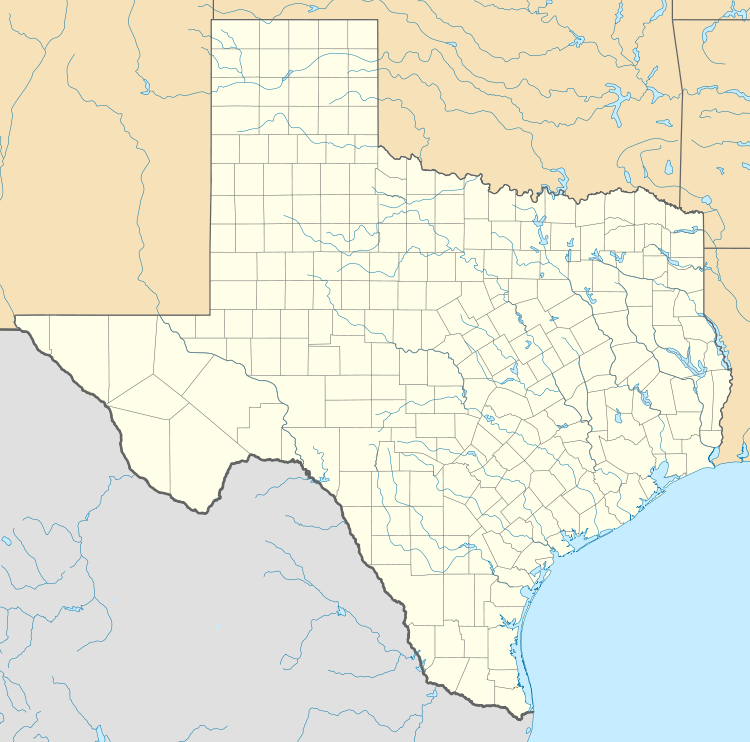Jester State Prison Farm
| Harlem | |
|---|---|
| Unincorporated community | |
| Jester State Prison Farm | |
 Harlem Location within the state of Texas | |
| Coordinates: 29°35′57″N 95°42′46″W / 29.59917°N 95.71278°WCoordinates: 29°35′57″N 95°42′46″W / 29.59917°N 95.71278°W | |
| Country | United States |
| State | Texas |
| County | Fort Bend |
| Elevation | 79 ft (24 m) |
| Time zone | Central (CST) (UTC-6) |
| • Summer (DST) | CDT (UTC-5) |
| ZIP codes | 77406 |
| Area code(s) | 713, 281, and 832 |
| GNIS feature ID | 1378416[1] |
The Jester State Prison Farm refers to a complex of Texas Department of Criminal Justice prisons for men in unincorporated Fort Bend County, Texas. Individually they are Jester I Unit, Carol Vance Unit (Jester II Unit), Jester III Unit, and Jester IV Unit.
Texas State Highway 99 (Grand Parkway) bisects the prison property.[2] Cornfields surround the Jester property.[3]
A portion of the property is within the Pecan Grove CDP.[4][5]
History
Previously the complex was known as Harlem, the Harlem Prison Farm, or the Harlem Plantation. The state of Texas purchased the prison farm property in 1885 or 1886. Previously the property held several private plantations that used convict leasing.[6] The plantations included the Harlem Plantation and several adjacent tracts of land.[7] Harlem I Unit and Harlem II Unit opened in 1885.[8][9]
From July 20, 1888 to August 31, 1907 a post office was located on the prison farm. After the post office closed, the post office in Richmond, Texas handled mail for the prison farm.[10]
In 1908 the State of Texas bought the Riddick Plantation, which was next door to the Harlem property. The state incorporated that property into the Harlem Farm.[7]
In September 1913 several prison guards in one of the units punished twelve African-American prisoners by placing them in a 9 feet 3 inches (2.82 m) long, 7 feet 3.5 inches (2.223 m) wide, and 6 feet 11.5 inches (2.121 m) high enclosure called "The Hole." The temperature in the enclosure went over 100 °F (38 °C), and convicts asked the guards to let them out. The guards did not let them out, and 8 of the 12 convicts died of suffocation.[6]
In 1925 the prison farm had 5,005 acres (2,025 ha) of land. During that year it had 260 prisoners. The complex received its current name, after Governor of Texas Beauford H. Jester, in the 1950s.[6]
A spur track of the Galveston, Harrisburg and San Antonio Railway opened at the prison farm to load and unload sugarcane that was produced at the farm. The railroad line closed in 1929.[6]
Jester III Unit opened in July 1982.[11] Jester IV Unit opened in November 1993.[12]
Gallery
- Aerial view of the Jester State Prison Farm, January 27, 2002, U.S. Geographic Survey
 Topographical map of the Jester Prison Farm, the Central Prison Farm, and Sugar Land Regional Airport, July 1, 1990, U.S. Geological Survey
Topographical map of the Jester Prison Farm, the Central Prison Farm, and Sugar Land Regional Airport, July 1, 1990, U.S. Geological Survey
References
- ↑ "Harlem, Texas". Geographic Names Information System. United States Geological Survey.
- ↑ Ward, Mike. "As prison closes, could others be next?" Austin American-Statesman. Thursday August 11, 2011. Updated on Friday August 12, 2011. Retrieved on September 23, 2011.
- ↑ Bookman, Marc. "How Crazy Is Too Crazy to Be Executed?" Mother Jones. Tuesday February 12, 2013. 3. Retrieved on March 23, 2013.
- ↑ "Pecan Grove CDP, Texas." U.S. Census Bureau. Retrieved on September 23, 2010.
- ↑ "Page-541." Texas Department of Transportation. Retrieved on October 5, 2011.
- 1 2 3 4 "Jester State Prison Farm." Handbook of Texas. Retrieved on October 6, 2010.
- 1 2 "Convict Leasing and State Account Farming (1883-1909)." Texas State Library and Archives. Retrieved on April 29, 2011.
- ↑ "Jester I Unit." Texas Department of Criminal Justice. Retrieved on May 9, 2010.
- ↑ "Vance Unit." Texas Department of Criminal Justice. Retrieved on May 9, 2010.
- ↑ "POSTMASTERS & POST OFFICES OF FORT BEND COUNTY, TEXAS 1846 - 1930." Jim Wheat's POSTMASTERS & POST OFFICES OF TEXAS, 1846 - 1930. Retrieved on October 12, 2011.
- ↑ "Jester III Unit." Texas Department of Criminal Justice. Retrieved on October 5, 2011.
- ↑ "Jester IV Unit." Texas Department of Criminal Justice. Retrieved on October 5, 2011.
External links
- Jester State Prison Farm from the Handbook of Texas Online